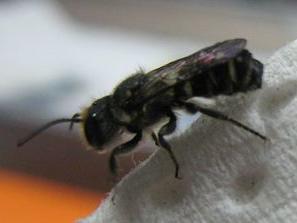
Help Native Bees Help Your Garden
A Sunset bee mystery.

There’s been a synchronicity of bees around here this week. The other day, Kimberley and I were discussing the National Wildlife Federation’s June/July story about the importance of native pollinators (and that means bees!) when we saw something crawling on the floor in her office.
It was a bee, the bee you see above, no longer than an eraser on a pencil.
We don’t know what kind of bee this is, but in the last two days, we’ve found seven of them crawling around the imaging department (two of them engaged in the activity that fulfills their half of The Birds & The Bees concept). We think they’re native bees, but we don’t know for sure.
Now, I’m no slouch when it comes to plant and animal identification. I love a good dichotomous key. But I have to admit, it was daunting to try to identify this little bee on The Bug Guide, a site that promises to help you identify insects, spiders, “and their kin.” Honestly, there are more kinds of bees on there than you’d find at an overturned Pepsi truck on the highway.
And that is exactly the point of the National Wildlife Federation’s story about native pollinators. It turns out that the numerous native bees of North America may be among the answers to the pollination woes brought about by the decline of the European honeybee. In California alone there are more than 1,600 known species of native bees, and there may be over 4,000 species of bees and wasps in North America. That’s a lot of pollinating possibilities.
But our native pollinators are at risk as well, through habitat and forage loss, pesticide use, and other troubles brought about by bees living wing to elbow with humans (a species, as you may have noticed, that is not in decline).
There’s good news. You, the human, can help native pollinators, and it’s not as hard as you might think. The National Wildlife story has tips that range from reducing your use of pesticides to becoming a “messy” gardener by leaving patches of unmulched soil and brush piles that pollinators can use for nests. (I wholeheartedly endorse and practice that advice).
And you can plant a bee-friendly garden. I like Urban Bee Gardens, a website with a whole hive full of information about bees and the gardens they love, including plant lists. And definitely read “In the Key of Bee,” in BayNature, for more information about bee gardens.
Or branch out and plant a garden that will attract may different types of pollinators—like butterflies, moths, bats, and birds. Pollinator.org has some nifty downloadable guides tailored to specific areas of North America.
Bee gardens aren’t just altruistic pursuits. Gardening to help pollinators will also help your garden, and you’ll reap the benefits with better yields of fruits and vegetables.
Happy bee gardening!
